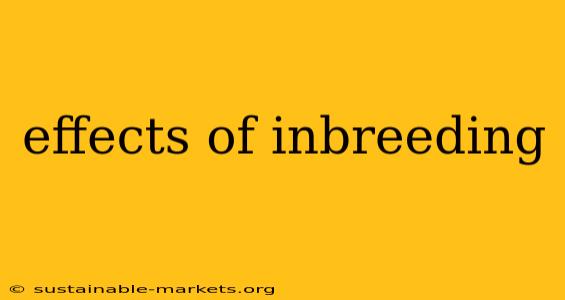Inbreeding, the mating of closely related individuals, has long been a subject of concern among biologists, geneticists, and even historians. While often portrayed dramatically in fiction, the real-world effects of inbreeding are significant and far-reaching, impacting not only individuals but also entire populations. This article delves into the genetic mechanisms behind these effects and explores the wide-ranging consequences.
Understanding the Genetic Basis of Inbreeding Depression
The core problem with inbreeding lies in the increased likelihood of homozygosity. Homozygosity refers to the presence of two identical alleles (versions of a gene) at a particular locus (location on a chromosome). While not inherently negative, inbreeding significantly increases the chance of inheriting two copies of a harmful recessive allele.
Recessive alleles only manifest their effect when present in two copies—one from each parent. In outbred populations, the chance of inheriting two copies of a harmful recessive allele is low. However, inbreeding dramatically increases this probability because related individuals share a greater portion of their genetic material. This increased homozygosity of recessive alleles leads to a phenomenon known as inbreeding depression.
Manifestations of Inbreeding Depression:
Inbreeding depression manifests in various ways, impacting an organism's overall fitness and survival. These effects can range from subtle to severe, and vary depending on the species and the specific deleterious alleles involved. Some common consequences include:
-
Reduced fertility: Inbred individuals often exhibit lower fertility rates, producing fewer offspring or having difficulty reproducing. This can be attributed to problems with gamete production (sperm and egg cells) or embryonic development.
-
Increased infant mortality: Higher rates of stillbirths and early deaths are frequently observed in inbred populations. This is directly linked to the expression of harmful recessive alleles that impair vital functions.
-
Lower growth rates: Inbred individuals may exhibit slower growth rates compared to their outbred counterparts. This reduced vigor can be observed across various life stages.
-
Increased susceptibility to disease: A weakened immune system and heightened vulnerability to infectious diseases are common consequences of inbreeding. The lack of genetic diversity limits the organism's ability to adapt and fight off pathogens.
-
Physical deformities and developmental problems: In severe cases, inbreeding can lead to various physical deformities and developmental abnormalities. These anomalies often result from the accumulation of multiple harmful recessive alleles.
Beyond the Individual: Population-Level Effects
The negative consequences of inbreeding extend beyond individual organisms, significantly affecting the long-term viability of populations. Reduced genetic diversity, a direct consequence of inbreeding, limits a population's ability to adapt to environmental changes, making it more vulnerable to extinction. This lack of adaptive potential is a major concern for conservation efforts, particularly with endangered species.
Examples in Nature and Human History
While the detrimental effects of inbreeding are well-documented, its occurrence varies across species and human populations. Examples of inbreeding's negative impact can be found in both the animal kingdom and throughout human history. Certain royal families, through centuries of consanguineous marriages, often experienced high rates of infant mortality and genetic disorders, highlighting the devastating consequences on a large scale.
Conclusion: The Importance of Genetic Diversity
The effects of inbreeding underscore the crucial importance of genetic diversity for the health and survival of both individuals and populations. Maintaining genetic diversity is essential for the long-term well-being of any species, from the smallest insect to the largest mammal, including ourselves. Understanding the mechanisms and consequences of inbreeding is paramount for conservation efforts, genetic counseling, and promoting the health of populations worldwide. Further research into the specific genetic factors and their interactions continues to expand our understanding of this complex phenomenon.

